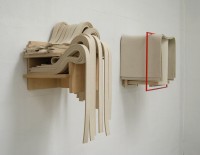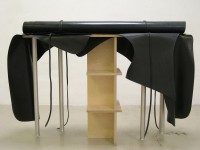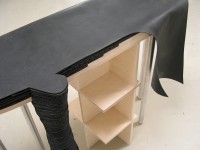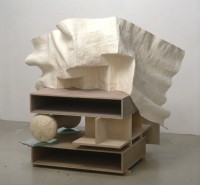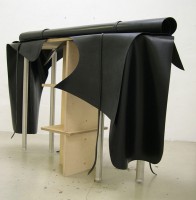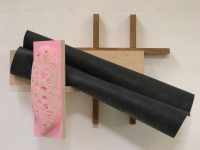De ongeveerkunde is een snelle manier van werken met een grote vrijheid.
Men werkt met de maatovereenkomsten en de maatverschillen van het materiaal dat voorhanden is. Doel van de ongeveerkunde is het eindresultaat, terwijl niet op voorhand vast staat hoe dat eruit ziet. Dat het werkproces zichtbaar blijft is niet van belang. Er worden snel beslissingen genomen. Het leidt echter niet tot chaos maar men zoekt voortdurend naar balans of het tegendeel daarvan.
Als er een maat niet past of een lengte te kort of te lang is, dit altijd oplossen met iets anders, dwz door toevoeging van een nieuw element. Er kunnen uiteenlopende materialen gebruikt worden. Als iets te groot is en kleiner moet kan dat ook met potlood aangegeven worden, of zelfs door middel van tekst, bijv: “dit is in werkelijkheid een stuk kleiner.”
Hoogst uitzonderlijk de zaag gebruiken, en in dat geval niet te lang over nadenken, gewoon doen. Oude tekeningen, verbeteringen en fouten niet te snel verwijderen, of beter helemaal niet verwijderen. Hooguit wegwerken met witte of zwarte verf. Kleur als het moet.
Alleen in laatste stadium de schaar. Het kan voor komen dat in dit laatste stadium materiaal nodig is wat niet voor handen is. Specifiek materiaal met een bepaalde afmeting gewoon bestellen bij de speciaalzaak indien nodig. Dit element wordt dan meestal het sluitstuk van het werk.
De ongeveerkunde kent geen abstracte of figuratieve restricties.
Als iets gefixeerd moet worden kan dat ook met touw of ander bindingsmateriaal. Tijdelijke zaken zoals pushpins en klemmetjes zijn geoorloofd, zelfs noodzakelijk, maar zij dienen vervangen te worden als het beter kan.
De ongeveerkunde is meestal ruimtelijk. In de meeste gevallen.
En hangt aan de muur, tenzij het op de grond ligt, of staat.
Englisch
Approximatology is a rapid way of working with a great degree of artistic freedom. One makes use of the similarities and differences in the size of the materials on hand. Approximatology’s objective is the end product, although how that will look is not determined beforehand. That the process remains visible is unimportant. Quick decisions are taken. This, however, does not lead to chaos but one continually looks for balance or the opposite of it. If a size does not fit or a length is too short or too long, always resolve this with something else, i.e. by adding a new element. Diverse materials can be used.
If something is too large and must be smaller, this can also be indicated in pencil, or even by means of a text, for instance: ‘in reality this is a bit smaller’. A saw should only be used under exceptional circumstances, and in that case, don’t think too long, just do it!
Do not remove previous sketches, corrections, and mistakes too quickly, or better not at all. At the very most, conceal with white or black paint. Colour, if absolutely necessary.
The scissor only in the last phase. It is possible in this last phase that a material is needed, but not on hand. If need be, a specific material of a certain dimension can be ordered at a specialty shop. This usually serves as the finishing element of the artwork.
Approximatology knows no abstract or figurative constraints.
If something must be secured, rope or another tying material is also acceptable. Temporary use of pushpins and fasteners is permissible, even unavoidable, but these ought to be replaced if it can be done better.
Approximatology is generally spatial. In most cases. And hangs on the wall, unless it lies on the ground, or stands.
© Semna van Ooy 2006
